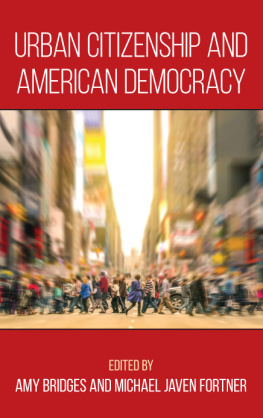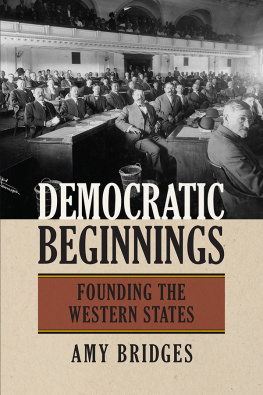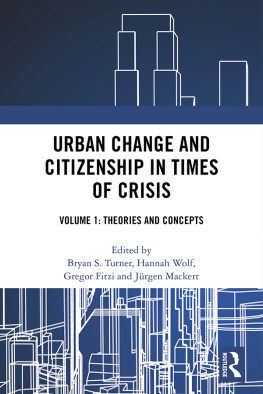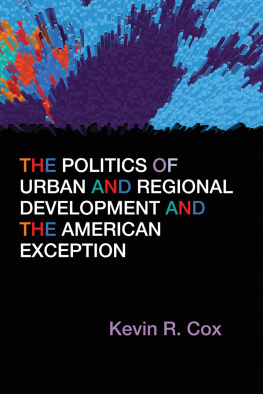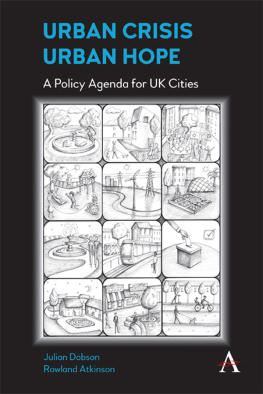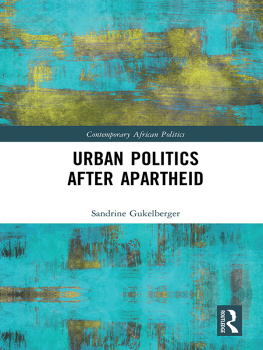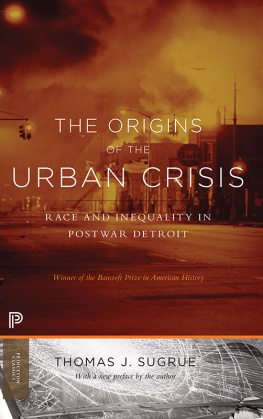Published by State University of New York Press, Albany
2016 State University of New York
All rights reserved
Printed in the United States of America
No part of this book may be used or reproduced in any manner whatsoever without written permission. No part of this book may be stored in a retrieval system or transmitted in any form or by any means including electronic, electrostatic, magnetic tape, mechanical, photocopying, recording, or otherwise without the prior permission in writing of the publisher.
For information, contact State University of New York Press, Albany, NY
www.sunypress.edu
Production, Eileen Nizer
Marketing, Anne M. Valentine
Library of Congress Cataloging-in-Publication Data
Names: Bridges, Amy, editor. | Fortner, Michael Javen, 1979 editor.
Title: Urban citizenship and American democracy / edited by Amy Bridges and Michael Javen Fortner.
Description: Albany : State University of New York Press, 2016. | Includes bibliographical references and index.
Identifiers: LCCN 2015027114 | ISBN 9781438461014 (hardcover : alk. paper) | ISBN 9781438461021 (e-book)
Subjects: LCSH: Municipal governmentUnited States. | Cities and townsUnited States. | CitizenshipUnited States. | DemocracyUnited States.
Classification: LCC JS323 .U73 2016 | DDC 320.8/50973dc23
LC record available at https://lccn.loc.gov/2015027114
10 9 8 7 6 5 4 3 2 1
Introduction to Cities and Citizenship
Amy Bridges
This volume originated at the Summer Seminar on the City: American Government as Urban Government, a conference held at Drexel University in 2011. Focusing on politics, the authors consider whether, or when, cities are better, and when they are worse laboratories of citizenship and democracy. Answering that question raises several others long asked about city governments: How can residents secure city governments responsive to public preferences? What can be accomplished by a group empowered in city politics? How limited is city government? When do urban citizens secure the attention of state and federal politicians? When can city government be autonomous of state and federal governments? Beyond the citys limits, the authors explore the potential meaning and consequences of urban citizenship for US politics. In this chapter, I review what scholars of urban politics know about democracy in city politics, the autonomy of cities, their place in US politics, the limits on city government, and a presentation of an active and creative role for cities in the process of globalization. The authors of the chapters here move our understanding of these most basic issues forward, some with cheering information and analysis, and others with sobering evidence and insight.
For those of us who live in a city or grew up in a city, urban citizenship is part of our identity. We commonly recognize urban identities in the character of people we meet, marking them as Angelenos, Chicagoans, Phoenicians, or New Yorkers (or, among New Yorkers, as from the Bronx, Manhattan, Queens, Staten Island, or Brooklyn). There are many ways to identify with, or be proud of, the city in which we live. There might be good weather, great museums, historic sites, strong neighborhood communities, architectural greatness, or equitable public policy. And of course there is politicsan honest and efficient government, an excellent school system, or a tradition of civil service. Some cities are more political than others, and popular culture exhibits this. A simple, unscientific way to discover local political culture is to ask a taxi driver, or a teacher, or a table attendant about an upcoming election. In Chicago or Washington, the answer is likely to be a disquisition on candidates, platforms, misdeeds, and likely popular support. In San Diego, the response is more likely to be I dont pay much attention to politics. City government, urban politicians, and local political institutions have much to do with how political residents are.
This follows from the ways cities share many of the properties we attribute to nation-states. Writing about nations, Theda Skocpol recognized that national governments have their own sets of electoral, administrative, and service institutions, and they (and the politics they generate) can operate according to their own logic. The same is true of cities. Like national states, cities impose taxes and fees, distribute jobs, goods, and services, and matter because their organizational configurations affect political culture, and encourage some kinds of group formation and collective action make possible the raising of [some] political issues and discourage the appearance of other issues. City governments influence the creation of interest groups and offer political lessons citizens may bring to other decisions, as when successful black mayors lower Anglo anxieties about voting for African American candidates. Although it is true that cities are legally creatures of their states, cities also have considerable authority and prerogatives: they raise their own revenues; have monopolies of certain functions for which they preside over employees, policies, and administration; and can be effective on their own behalf.
The authority and scope of city government have made it possible for skillful politicians to improve the well-being of urban residents. The constructive possibilities of city government can be seen in the administrations of the early twentieth-century social reform mayors Hazen Pingree (Detroit), Tom Johnson (Cleveland), and Sam Golden Rule
More commonly, the authority and domain of city governments have enabled them to establish parks and school systems; supply drinking water and pick up the garbage; create mass transportation in trains, trolleys, and buses; support museums; and innovate in systems of criminal justice. So we know that, for all of our discussion of limits, control of city government conveys wide-ranging powers. Groups empowered by city government have these resources at hand, although, like Pingree and other social reformers, politicians leading their efforts will encounter resistance from several quarters.
What of democracy in cities? In the eighteenth century, it was the great discovery of citizens in the thirteen colonies that elections were an effective way to tie politicians to public sentiment. They came to this by comparing the behavior of colonial governors, who were appointed by the Crown, and members of colonial legislatures, who were elected. In the nineteenth century, residents were keenly aware that they were citizens or residents of a democratic republic, contrasted often by political leaders and the press with the subjects who endured monarchs and despots elsewhere. It was the republican government of the United States
Elections remain the central institutional arrangement for citizens to tie city government to popular preferences. Yet all elections are not equal; rules and institutions matter. Cities make choices in arranging elections and public institutions. They may have mayor-council, city manager, or commission government. Elections may or may not be held concurrently with elections for state or federal offices. Polling places may be open only one day or on several days; they may be open for many hours, accommodating people in the labor force as well as those with more time. Candidates may have party designations, or elections may be nonpartisan. City governments set residence and registration requirements for voters. Each of these choices will influence who votes, how much their votes count, and who is likely to hold public office. Finally, politicians, their supporters, and political party or Nonpartisan Slating Groups activists may walk precincts, knock on doors, and remind people to vote.

